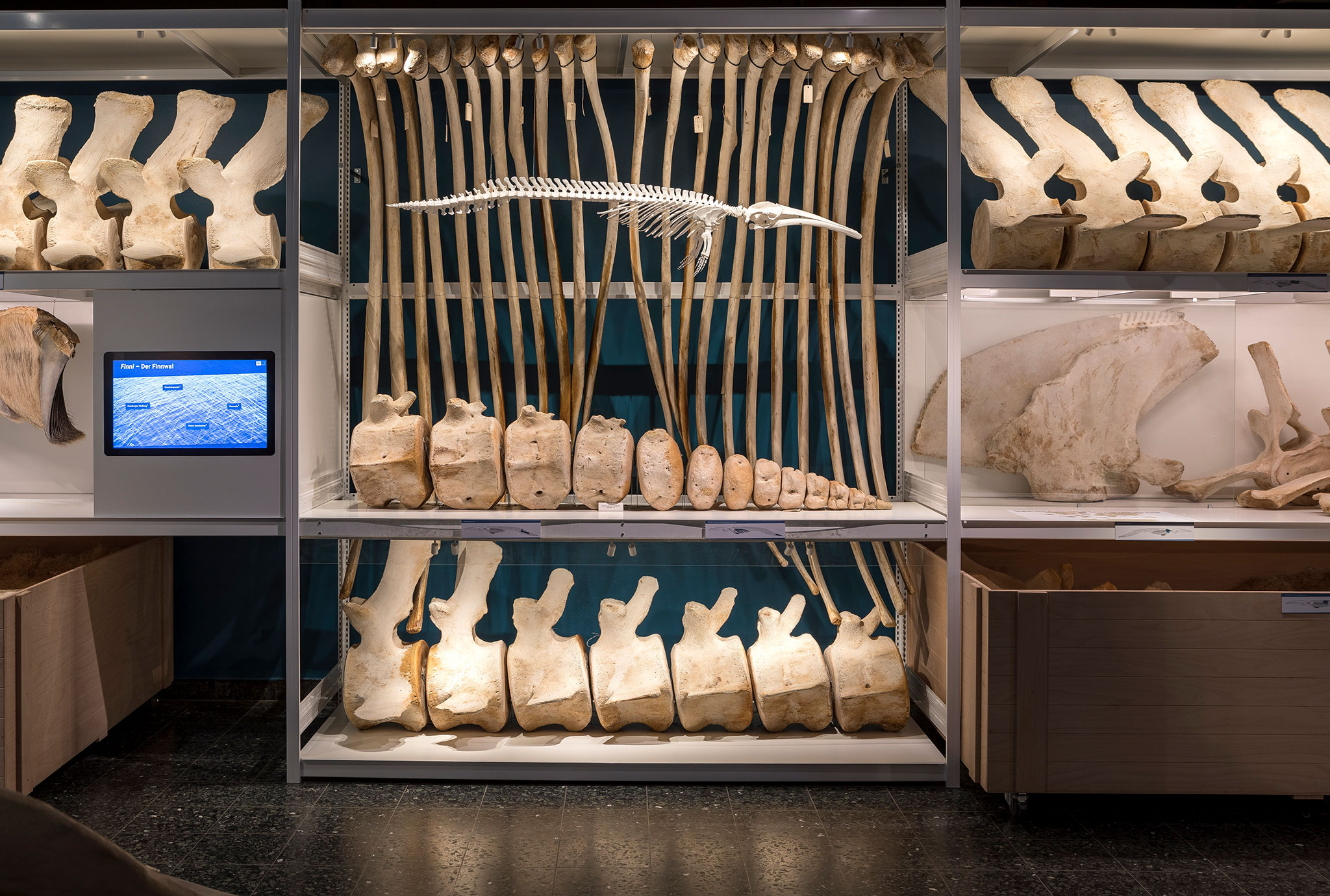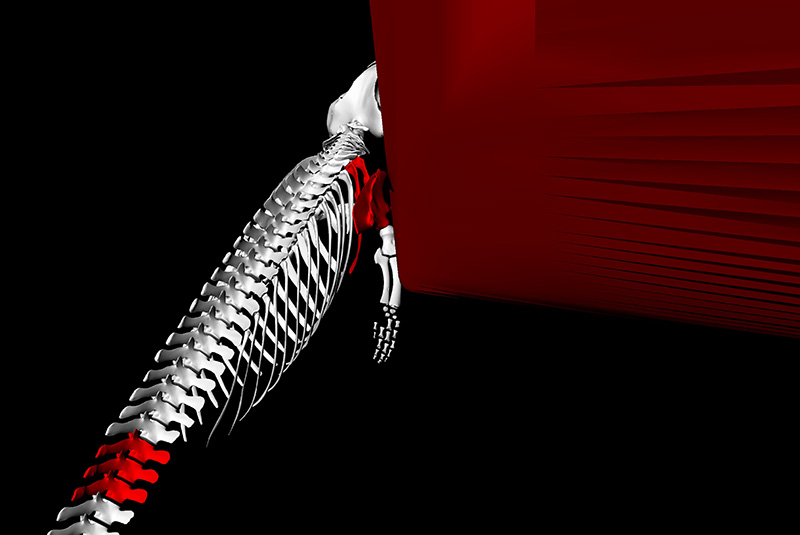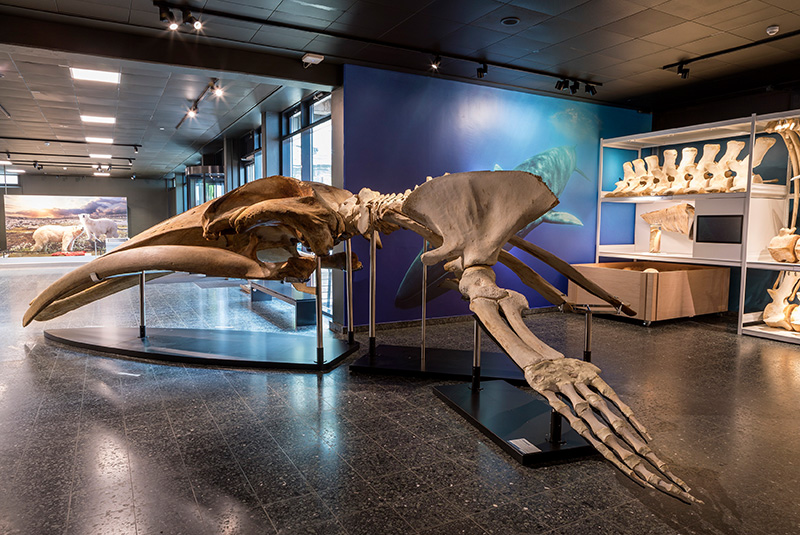Study proves collision of fin whale with ship
 While Finni’s skull including the shoulder section can be seen in the museum foyer, the whale bones are presented as if in a depot. On the shelf, you can see the broken right shoulder blade and a row of broken and healed vertebral processes at the top right next to it. The skeleton was mounted as a 3D model in a ratio of 1:10. Photo: UHH, Mentz
While Finni’s skull including the shoulder section can be seen in the museum foyer, the whale bones are presented as if in a depot. On the shelf, you can see the broken right shoulder blade and a row of broken and healed vertebral processes at the top right next to it. The skeleton was mounted as a 3D model in a ratio of 1:10. Photo: UHH, Mentz
Finnis’ imposing skull with its powerful shoulder section cannot be overlooked in the foyer of the Museum der Natur Hamburg. If you look closely, you can see all kinds of unusual knobbly growths on the fin whale’s shoulder blade. Now a study by the LIB published in the scientific journal Plos One proves that Finni survived the collision with a large ship with severe bone fractures and suffered from post-traumatic postural damage and arthrosis for many years. This study is the first detailed reconstruction of a historic whale-ship collision in the Southern Hemisphere seas, dating back to the 1940s.
With the life and suffering story of the adult fin whale of almost 20 metres in length, more than just an individual fate is reconstructed. Ship accidents have become a major threat to whales in the 20th century, as the size and speed of ships and also traffic as a whole have greatly increased. Fin whales are among the species most frequently hit by ships and seriously injured. Using the skeleton of Finni, it has now been possible for the first time to reconstruct the consequences of such a collision in three dimensions.
The study also describes the fate of a whale that is likely to go down in the history of German whaling as one of the last victims. Finni was killed in 1952 by the fleet of the Greek shipowner Aristotle Onassis in the Southern Ocean, at a time when no whales were actually allowed to be hunted under the German flag. However, the Hamburg biologist Kurt Schubert was on board and saved the skeleton for the then Zoological Museum in Hamburg – today the Hamburg Museum of Nature. Here the bones were well stored in the scientific collection for decades before they were scientifically examined for the first time a few years ago as part of a research project on the health of marine mammals.
To analyse the bone changes, the authors created a 3D model of the surfaces of each bone and then virtually reassembled the skeleton. This made it possible to measure all deviations from the natural symmetry of the body. The diagnosis: Finni suffered from osteoarthritis, among other things. Some ribs and some vertebral processes showed healed bone fractures. The right shoulder blade was virtually shattered before it finally grew back together, offset and shortened, in a long and painful healing process.
The bent vertebral processes indicate a permanent postural defect that developed from a long-lasting protective behaviour and ultimately must have severely restricted the animal’s mobility for many years. The authors suspect that the broken scapula severely impaired the movement of the right arm in particular. “Since the whale has difficulty resting its arms, because it cannot steer or dive without them, the broken shoulder blade could only heal very slowly. So we can assume that the time of the collision must be many years before the fin whale was shot in 1952. So we know that the collision with the ship took place in the 1940s,” says Prof. Dr. Thomas Kaiser, Section Head Mammalogy & Palaeoanthropology at the Leibniz Institute for the Analysis of Biodiversity Change (LIB), Museum der Natur Hamburg.
The researchers also animated the digitised model and thus visualised the scenario of a plausible ship-whale collision and its consequences for the whale. Considering the size of the animal, only a virtual model of the skeleton allows us to reconstruct the collision and the spatial and temporal course of the injuries in relation to the ship’s hull,” says Viola Daume, who played a major role in designing the study as her final thesis.
The study therefore used various 3D surface modelling techniques to create a virtual model of the entire fin whale skeleton. “The digital model is perfect for visualisation,” says Kaiser. A scaled-down 3D printout also makes it possible for the public to experience the huge skeleton, as there will probably only be space for the mounted original in the new museum building in Hamburg’s HafenCity.
Original publication:
OSTEO-PATHOLOGICAL ANALYSIS PROVIDES EVIDENCE FOR A SURVIVED HISTORICAL SHIP STRIKE IN A SOUTHERN HEMISPHERE FIN WHALE (BALAENOPTERA PHYSALUS) | PLOS ONE
Contact:
Leibniz Institute for the Analysis of Biodiversity Change (LIB)
Museum of Nature Hamburg
Prof. Dr. Thomas M. Kaiser
Head of Section Mammalogy & Palaeoanthropology
T.Kaiser@leibniz-lib.de






